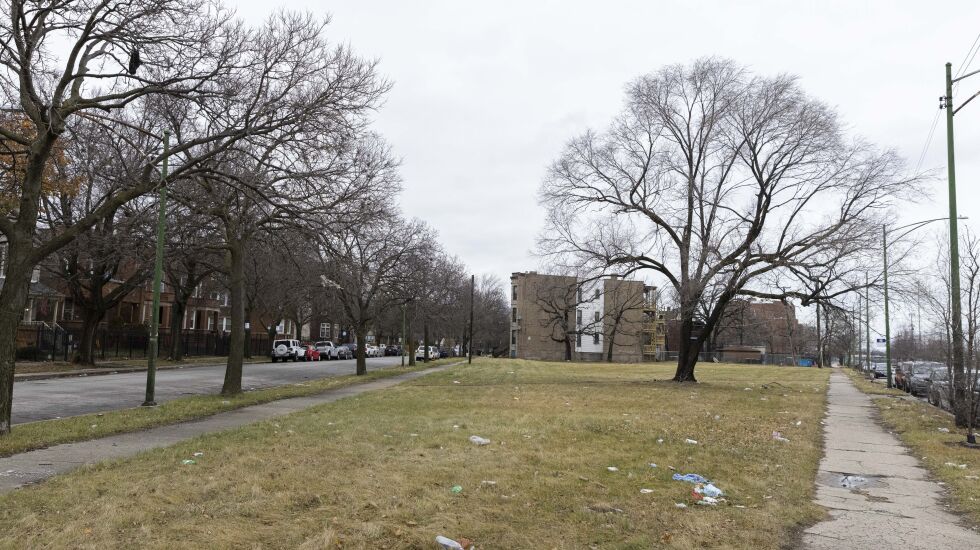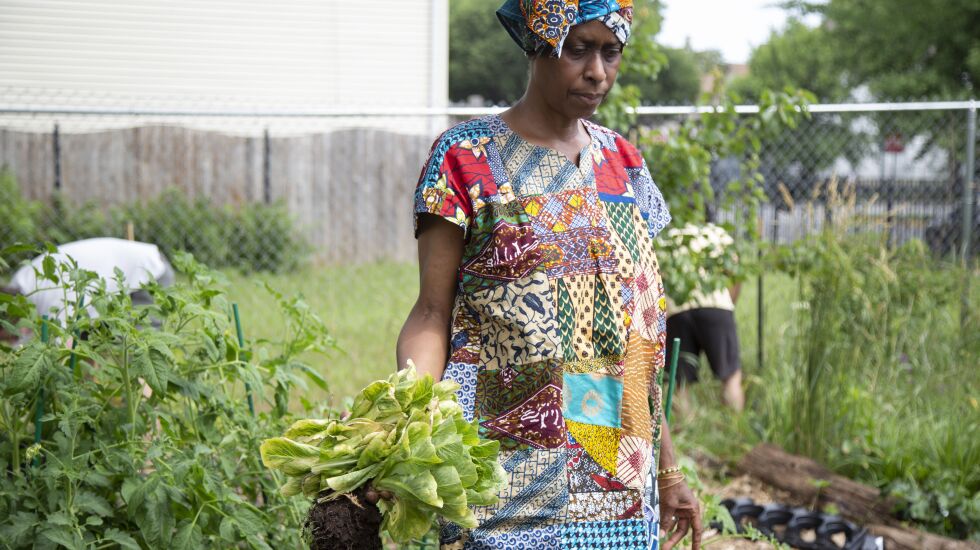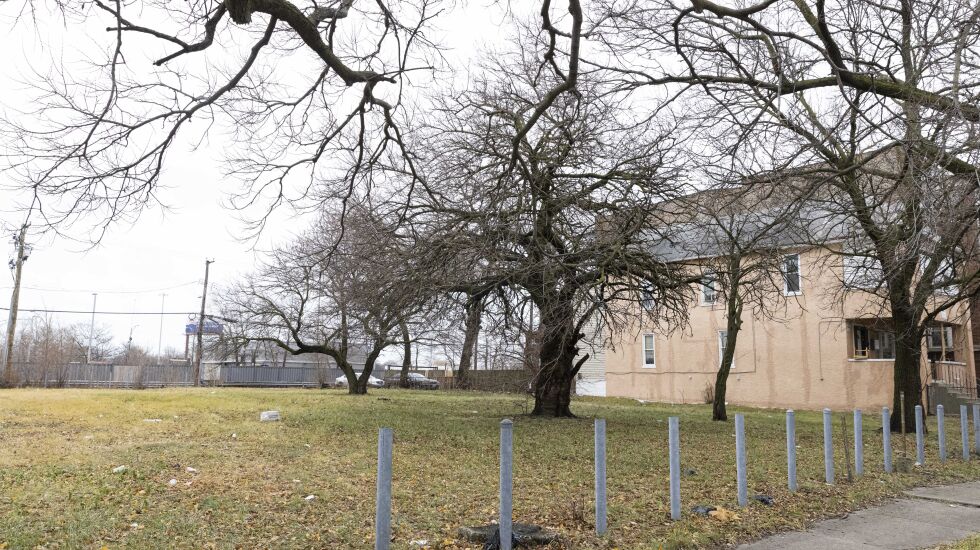
Six years ago, Mekazin Alexander bought a 6,000-square-foot lot several houses down from where she owns a home in Englewood.
It cost her a dollar.
She bought the lot as part of Large Lots, a program initially spearheaded by Englewood residents and adapted by the city in 2015.
Alexander turned the unkempt lot into a thriving community space and garden, Earl’s Garden Mae’s Kitchen. Fruit trees decorate the space that is also home to events where residents can gather, complete with fire pits and a stage. Food from the garden is given away.
Without the program, Alexander says that community space wouldn’t be there.

A few years after shutting down the program, the city is preparing to relaunch it next year, with more than 2,000 vacant, city-owned lots on the South and West sides going up for sale.
But this time around, instead of aiming the program at local homeowners looking to remedy vacant lots in their communities, the city is changing the rules in an effort to develop new housing.
For example, all lots have passed environmental inspections, and potential buyers must file a plan and timelines for the space with the city.
But the biggest difference: Instead of costing $1, lots will be sold for at least 10% of the market rate, a change that has enraged some residents.
Its guidelines invite outside developers to create new housing when the South Side already has a large amount of vacant housing, said Asiaha Butler, executive director of the Resident Association of Greater Englewood.
By contrast, the low cost of the original program, which ran from 2015 to 2018, let South and West siders develop solutions for vacant spaces in their neighborhoods.
“It’s really sad to look at; it’s almost no opportunities for homeowners,” Butler said, calling the new program a “developer’s dream.”
“To me it’s a fast track to gentrification.”
A map of available lots, as well as others owned by the city, can be found on the program’s website, chiblockbuilder.com. Applications for lots are due Feb. 3. The city will host its next information session online Jan. 12 at 10:30 a.m.
The list of allowed uses for the lots includes market-rate or affordable housing, side yards for homeowners living adjacent to those vacant lots; commercial and mixed-use developments; and open space, such as parks or gardens.
In Englewood, where 253 of 1,057 city-owned lots will go on sale, residents have had several “fiery” meetings with city officials since the new program was announced, Butler said.

Margaret Decker, a member of the mayor’s economic development team, said complaints about the price hike were valid but cited issues with the original program as the reason for the changes.
“We ran into a number of internal and environmental issues with some of the land,” she said.
Complaints stacked up, she said.
“People in the community and some of the City Council members felt that the dollar loss program was devaluing the land in their communities,” she said.
“What we really want to focus on is bringing a lot more transparency to the land sale process,” she said, citing the program website and application process.
Decker also cited a need to encourage more housing developments.
“We know that there’s a huge need for housing in Chicago and particularly on the South and West sides. We’re seeing an exodus of people from the city and so we’re trying to facilitate opportunities for more housing development.”
Talei Thompson, a community engagement manager with the city of Chicago, said many West Siders he’s spoken to are excited for the program.
“Individuals are eager, they’re just really, really excited about [what] they deem as an opportunity to not only repopulate our communities, but to be a part of the hands-on redevelopment of our communities,” he said.
Thousands of city-owned lots throughout the city remain off the market because they did not pass environmental reviews, including making sure that the lot wasn’t previously used for businesses that could have a potentially toxic impact on the land, such as a gas station.
Mike Tomas, the president of the Garfield Park Community Council and a resident of East Garfield Park, where 42 of 468 lots will go up for sale, applauded that all the lots being sold have passed environmental reviews, saving buyers months of time and thousands of dollars.
Another problem with the last program, Tomas said, was that buyers didn’t have to provide a timeline to realize their stated use for the land and sometimes it remained vacant.
This time, buyers have to submit a timeline for projects and plans that don’t conform to current zoning would be subject to review by the City Council, program leaders announced at an online information session in early December.
“Hopefully having a plan for what to do with the lots will spur a lot of development and not just more speculation,” Tomas said.
Craig Chico, president of the Back of the Yards Community Council in the New City community area, where 404 of 499 lots are going up for sale, said not having a plan in place for the lots wasn’t an issue.
“There’s nothing wrong with having a double lot of it’s cleaned, it’s good for the neighborhood and back on the tax rolls,” he said.
But he praised the fact that the program had returned at all and that lots would be open to residents for 10% of the market rate.
“You’re looking at city blocks that have nothing but blight. Now a guy can go in, buy it at a subsidized rate and fix it up and turn it into something nice for the community.”
He just hopes to be able to find subsidies that locals as well as nonprofits like the community council can use to help purchase lots.

Steven Vance, an urban planner that runs several Chicago-focused accounts and a real estate information website, followed the successes and failures of the original program and feels the new program has improved some aspects.
The original, he said, was prone to corruption and a lack of transparency when it came to who would get the lots. The new program’s map component that lets buyers sort properties by land use makes it clearer how the city expects the land to be used.
Price, however, is an issue with the new incarnation, he said.
“The problem becomes, which this program doesn’t necessarily address is, how do we help that person obtain money to actually fulfill their vision,” he said.
“There’s room for the city to modify their program to do different incentives or discounts or waivers or exemptions, or grants to help people deal with that.”
Back in Englewood, Alexander made the same point, arguing that the new program lost part of what made the original so transformative.
“Myself and many of the residents that are in the Englewood community could not afford 10% of the market value of the lot,” Alexander said. “And why should they? Why are we paying for vacant property that we literally want to upkeep and turn into something that would be beneficial to the community?”
“To eliminate a program that’s working and substitute it for something that is not equitable for everyone is not the direction that it should go.”
Mariah Rush and Michael Loria are staff reporters at the Chicago Sun-Times via Report for America, a not-for-profit journalism program that aims to bolster the paper’s coverage of communities on the South Side and West Side.








